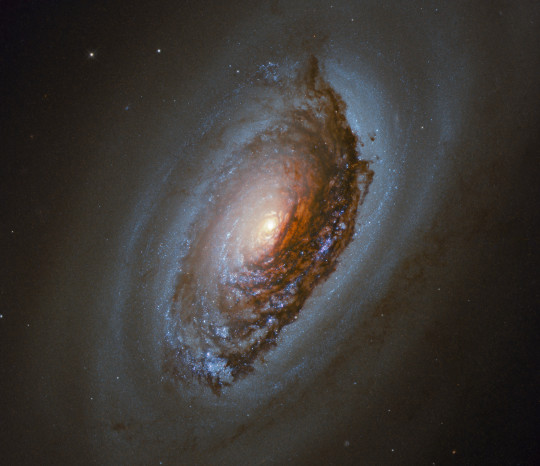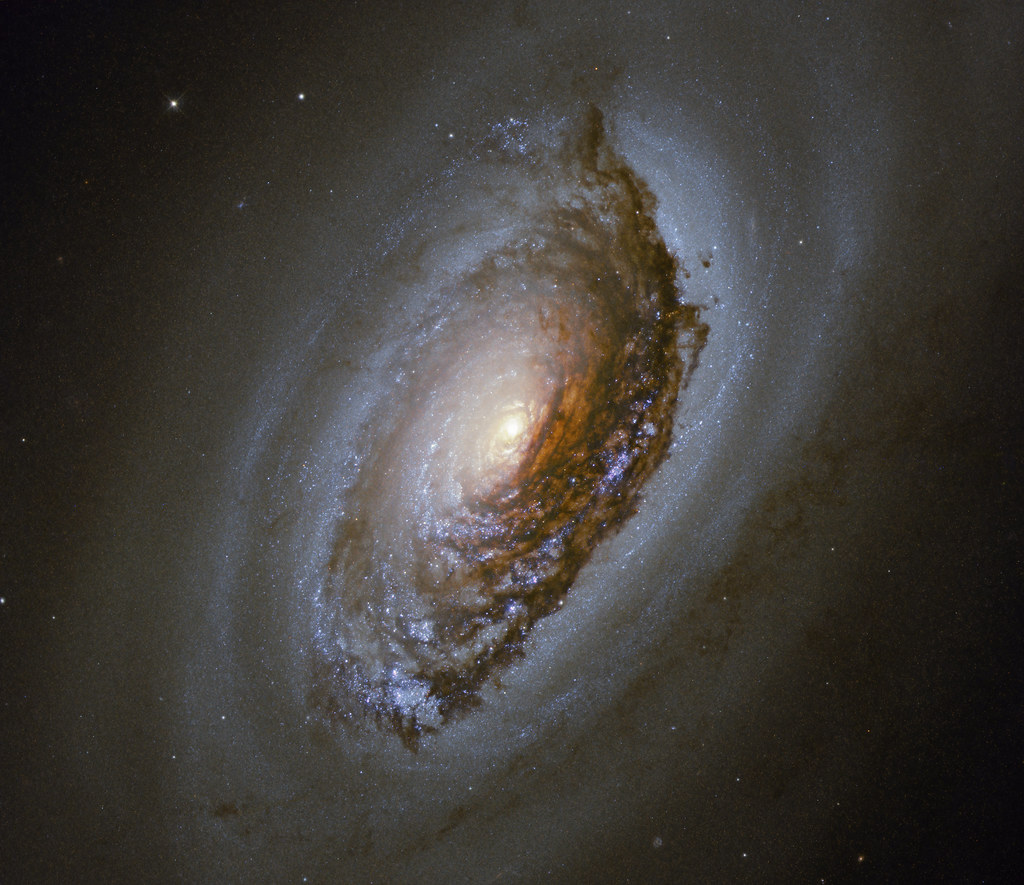#NGC 4826
Text

The Black Eye Galaxy, M64 // Don Elledge
Up close and personal, now you can really see the dark dust lane at the center! You can also see (or rather not see) a distinct lack of well-defined spiral arms!
This is likely caused by the two counter-rotating disks of equal mass that make up the Black Eye Galaxy. The inner disk contains the dust lanes at the center. These disks were likely created when M64 merged with a satellite galaxy in a retrograde (i.e., backwards) orbit.
#astronomy#astrophotography#messier marathon#galaxy#spiral galaxy#star-forming galaxy#black eye galaxy#messier#messier 64#M64#NGC 4826#coma berenices
44 notes
·
View notes
Text

NGC 4826 (Black Eye Galaxy).
Distance: 22000–26000 light-years.
#space#follow#followback#science#nature#astronomy#Universe#Cosmos#Astrophotography#NASA#nebula#night sky#stars#galaxy#Black Eye Galaxy
939 notes
·
View notes
Text

M64: The Sleeping Beauty Galaxy - December 15th, 1995.
"The Sleeping Beauty galaxy may appear peaceful at first sight, but it is actually tossing and turning. In an unexpected twist, observations have shown that the center of this photogenic galaxy is rotating in the opposite direction than the outer regions! Stranger still - there is a middle region where the stars rotate in the opposite direction from the surrounding dust and gas. The fascinating internal motions of M64, also cataloged as NGC 4826, are thought to be the result of a collision between a small galaxy and a large galaxy - where the resultant mix has not settled down."
32 notes
·
View notes
Text

M64, NGC 4826 The Black Eye Galaxy
Constellation Coma Berenices
Distance: 24 million ly
April 16 to 18 2023 -Montcada i Reixac
#astrophotos#astronomy#astrophotography#cosmos#universe#galaxy#original photographers#messier 64#black eye galaxy#urban astrophotography
29 notes
·
View notes
Photo

I done a space one!!
Get it while you can, I never seem to have them for long.
The Black Eye Galaxy designated M64, or NGC 4826 is a spiral galaxy 17 million light-years away in the constellation of Coma Berenices.
I've put the #drawing in my shop. There’s a link attached.
2 notes
·
View notes
Text
The Black Eye Galaxy
The Black Eye Galaxy, M64
#astronomy #galaxy #black_eye #m
Messier 64
A Spiral Galaxy in Coma Berenices.
Also known as NGC 4826
Image exposure:100.5 MinutesImage Size:34.3 x 26.9 arcminImage date:2023-05-18
I was planning for a three hour exposure of this super-interesting galaxy but the session was curtailed by cloud interference, nothing new there, so I achieved just one hour and 40 minutes.
Messier 64 is called the Black Eye Galaxy because of the…

View On WordPress
#amateur astronomy#Astronomy#Black Eye Galaxy#coma berenices#Cosmic Focus Observatory#cosmos#deep sky#Featured#image#M64#Messier 64#nature#Nebula#photography#science#Skywatcher EQ6-R#Skywatcher esprit 120#space#Universe#ZWO ASI071
0 notes
Photo

Evil Eye Galaxy
263 notes
·
View notes
Photo

(c) ESA/Hubble & NASA, J. Lee and the PHANGS-HST Team - Acknowledgement: Judy Schmidt
This NASA/ESA Hubble Space Telescope image features NGC4826 — a spiral galaxy located 17 million light-years away in the constellation of Coma Berenices (Berenice’s Hair). This galaxy is often referred to as the “Black Eye”, or “Evil Eye”, galaxy because of the dark band of dust that sweeps across one side of its bright nucleus.
NGC4826 is known by astronomers for its strange internal motion. The gas in the outer regions of this galaxy and the gas in its inner regions are rotating in opposite directions, which might be related to a recent merger. New stars are forming in the region where the counter rotating gases collide.>
Read more.
#european space agency#space#hubble#hubble space telescope#esa#nasa#space science#galaxy#ngc 4826#black eye#astronomy
14 notes
·
View notes
Text
Телескоп «Хаббл» зробив світлину яскравої галактики в сузір'ї Волосся Вероніки
Телескоп «Хаббл» зробив світлину яскравої галактики в сузір’ї Волосся Вероніки
Телескоп Hubble, який є спільним проектом Національного управління з аеронавтики й дослідження космічного простору США (National Aeronautics and Space Administration, NASA) та Європейського космічного агентства (European Space Agency, ESA), зробив знімок спіральної галактики NGC 4826, яка розташована в сузір’ї Волосся Вероніки на відстані 17 мільйонів світлових років від Землі.
Галактика NGC 4826…

View On WordPress
#Волосся Вероніки#Галактика#США#Спляча Красуня#Сузір’я#Телескоп#Хаббл#ESA#European Space Agency#HST#Hubble#Hubble Space Telescope#NASA#NGC 4826#USA
0 notes
Photo

THE BLACK EYE GALAXY
Dark lanes of light-absorbing dust obscure the bright nucleus of M64, or the Black Eye Galaxy. M64's collision with a smaller satellite galaxy produced some unusual physical processes. While the all the stars in the Black Eye Galaxy rotate clockwise as seen in this image, interstellar gas around the edges moves in the opposite direction.
As the gas in the inner region, spanning 3000 light-years, collides with the gas that rotates in the opposite direction, the gasses compress and contract to form new stars. M64 is popular with amateur astronomers and can be spotted 17 million light-years distant in the Coma Berenices constellation.
-RLO
Sources: Judy Schmidt from USA - NGC 4826
https://www.flickr.com/photos/geckzilla/49659407432/
Image credit: NASA and The Hubble Heritage Team (AURA/STScI)
39 notes
·
View notes
Text

The Black Eye Galaxy, M64 // David Cheng
Named for the large dark band of dust in front of its central region, the Black Eye Galaxy is home to about 100 billion stars and is about 17.3 million light years away (although that distance estimate is uncertain).
This galaxy was discovered in 1779 by Edward Pigott (1753-1825) and later added to Messier's catalog. it was William Herschel (1738-1822) who observed it in 1787 and gave it its moniker: "... contains one lucid spot like a star with a small black arch under it, so that it gives one the idea of what is called a black eye, arising from fighting."
#astronomy#astrophotography#messier marathon#galaxy#spiral galaxy#black eye galaxy#messier#messier 64#M64#NGC 4826#coma berenices
22 notes
·
View notes
Photo

A veces al mirar el cielo te devuelven la mirada. M 64, el Ojo Negro u Ojo Maligno es una galaxia espiral algo solitaria en la constelación Coma Berenices. Su nombre se debe a la banda de polvo que oscurece parte de la luz proveniente de su centro. Celestron C8 reductor focal 6.3 Ioptron GEM 45 Canon EOS Rebel T7 308x60s total 5hr 8 min ISO 400 DSS, PixInsight. Maipú, Santiago, Chile. 28.06.2021 M 64, NGC 4826, The Black Eye Galaxy #astrophotography #astrofotografiachile #celestron #ioptron #canon #cosmos #astronomy #universe #pixinsight #galaxy (en Maipú, Chile) https://www.instagram.com/p/CQzgr-hsgQ0/?utm_medium=tumblr
#astrophotography#astrofotografiachile#celestron#ioptron#canon#cosmos#astronomy#universe#pixinsight#galaxy
2 notes
·
View notes
Video
Eye in the sky by European Space Agency
Via Flickr:
This NASA/ESA Hubble Space Telescope Picture of the Week features NGC4826 — a spiral galaxy located 17 million light-years away in the constellation of Coma Berenices (Berenice’s Hair). This galaxy is often referred to as the “Black Eye”, or “Evil Eye”, galaxy because of the dark band of dust that sweeps across one side of its bright nucleus. NGC4826 is known by astronomers for its strange internal motion. The gas in the outer regions of this galaxy and the gas in its inner regions are rotating in opposite directions, which might be related to a recent merger. New stars are forming in the region where the counter rotating gases collide. This galaxy was first discovered in 1779 by the English astronomer Edward Pigott. Credits: ESA/Hubble & NASA, J. Lee and the PHANGS-HST Team; CC BY 4.0 Acknowledgement: Judy Schmidt
#NGC 4826#ESA#European Space Agency#Space#Universe#Cosmos#Space Science#Science#Space Technology#Tech#Technology#HST#Hubble Space Telescope#Galaxy#Supernova#NASA#Spiral Galaxy#Coma Berenices
1 note
·
View note
Link
Photoworks in honor Black Eye Galaxy Created by Anna Sonnemann SƧS ©
Black Eye Galaxy, Beauty Eye Galaxy, Sleeping Beauty Galaxy, Evil Eye Galaxy, KARA 559, NGC 4826, PGC 44182, UGC 8062, Messier 64, M64
#black eye galaxy#The Black Eye Galaxy#Beauty Eye Galaxy#Sleeping Beauty Galaxy#evil eye galaxy#kara 559#NGC 4826#PGC 44182#UGC 8062#Messier 64#M64#anna sonnemann#Anna Krypto'nell Sonnemann#SƧS#I Love Black Eye Galaxy
0 notes
Photo

The Black Eye Galaxy (also called Sleeping Beauty Galaxy or Evil Eye Galaxy and designated Messier 64, M64, or NGC 4826) is a relatively isolated spiral galaxy 17 million light-years away in the mildly northern constellation of Coma Berenices. It was discovered by Edward Pigott in March 1779, and independently by Johann Elert Bode in April of the same year, as well as by Charles Messier the next year. A dark band of absorbing dust partially in front of its bright nucleus gave rise to its nicknames of the "Black Eye", "Evil Eye", or "Sleeping Beauty" galaxy. M64 is well known among amateur astronomers due to its form in small telescopes and visibility across inhabited latitudes.
This galaxy is inclined 60° to the line-of-sight and has a position angle of 112°. At the distance of this galaxy, it has a linear scale of 65 ly (20 pc) per arcsecond. The morphological classification in the De Vaucouleurs system is (R)SA(rs)ab, where the '(R)' indicates an outer ring-like structure, 'SA' denotes a non-barred spiral, '(rs)' means a transitional inner ring/spiral structure, and 'ab' says the spiral arms are fairly tightly wound. Ann et al. (2015) gave it a class of SABa, suggesting a weakly barred spiral galaxy with tightly wound arms.
M64 is a type 2 Seyfert galaxy with an HII/LINER nucleus. The central region is a weak source of radio emission. A soft X-ray source has been detected at the nucleus, which is most likely coming from the circumnuclear region rather than directly from an active galactic nucleus. There is an inner disk of molecular gas that is truncated at a radius of 2,300 ly (700 pc). At present, the non-rotational motions of this disk do not significantly feed the core, but the disk does produce a vigorous rate of star formation, with also approximately 100 billion stars inside the galaxy. There is also evidence of a recent large inflow of mass.
The interstellar medium of Messier 64 consists of two counter-rotating disks that are approximately equal in mass. The inner disk contains the prominent dust lanes of the galaxy. The stellar population of the galaxy exhibits no measurable counter-rotation. Possible formation scenarios include a merger with a gas-rich satellite galaxy in a retrograde orbit, or the continued accretion of gas clouds from the intergalactic medium. It has a diameter of 54,000 ly (17 kpc).
0 notes
